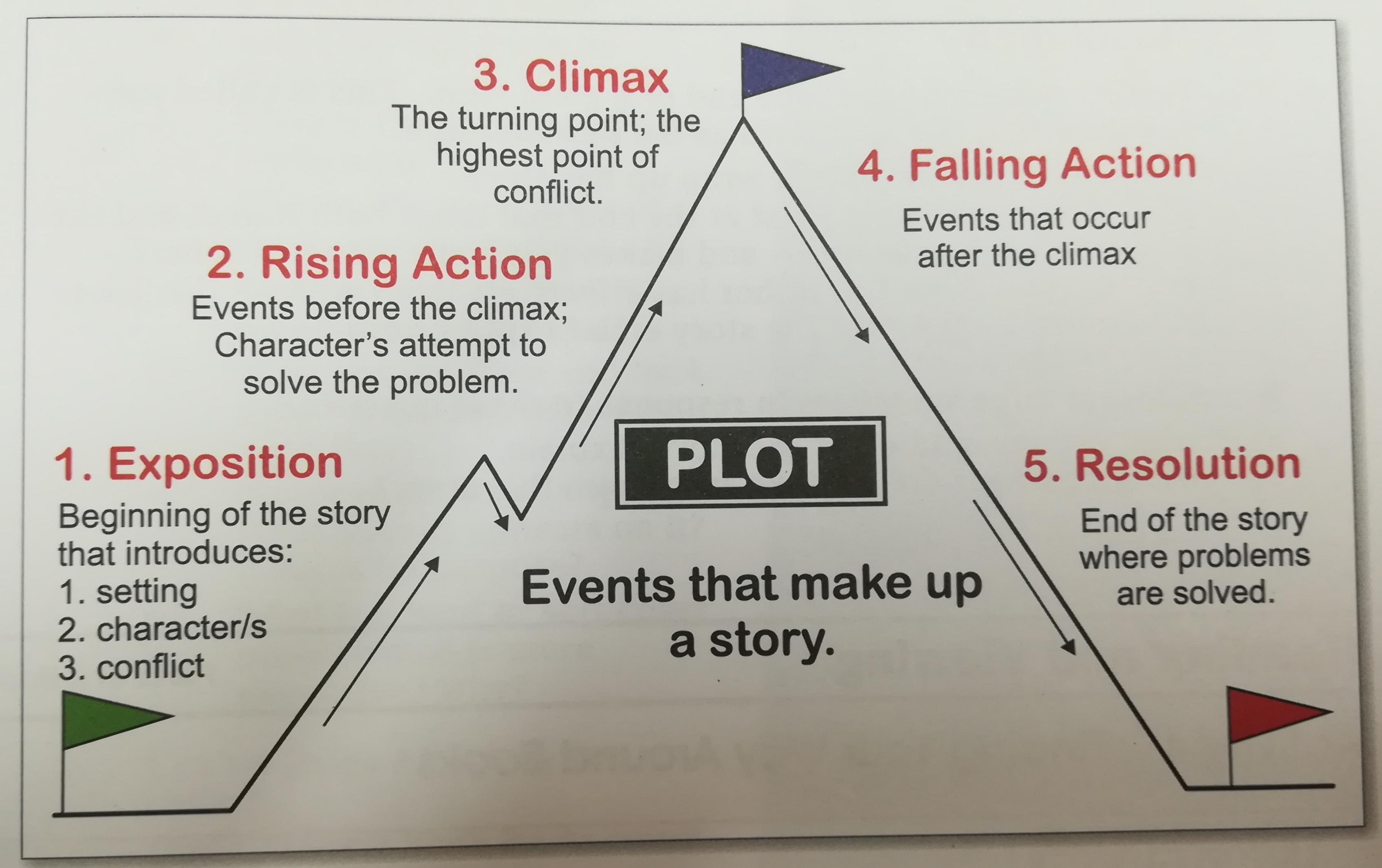Introduction to a novel - Lesson 3 Term 1 2021

19/03/2021
Dear grade 8s
The following notes are an introduction to studying a novel. These notes must be entered into your literarure notebook under the novel section. All diagrams used in the notes must be drawn into your books. Be creative and use colour.
What is a novel?
A novel is a book – length fictional prose narrative that contains six primary elements: character, plot, point of view, setting, style, and theme.
Definitions:
Footnote: An additional piece of information printed at the bottom of the page.
Climax: The highest point of conflict. Generally, a turning point in the story.
Chapter: A main division in the book, usually indicated by a title or number.
Premonition: A strong feeling that something is going to happen.
Exposition: Beginning of the story that introduces the setting, characters and conflict.
Plot: Is the sequence of events that make up a story.
Foreshadowing: When the author hints that something is going to happen later.
Theme: The main idea of the story – the message.
Protagonist: The main character/s.
Secondary characters: Are characters that feature in the story but do not dominate the storyline.
Index: Alphabetical list of names, subjects etc. in a book with reference to the pages on which they are mentioned; usually appears at the back of a book.
Glossary: Alphabetical list of (new) words in a book; a mini dictionary found at the back.
Appendix: A section of supplementary (additional) matter at the end of the book.
Antagonist: The character who opposes or is hostile toward the protagonist.
Notes:
· The characters of any novel are its actors—those people who perform actions and who are the recipients of actions. In the first Harry Potter novel, the protagonist (main character) is Harry Potter himself, but he is joined by a whole host of other characters
· A novel's plot is its storyline, which begins with an exposition, rises in action and tension until it reaches its climax, and then resolves in its ending.
· All novels are told from a point of view, which is a perspective on the action. Sometimes we have a third-person narrator who is not otherwise part of the story.
· Setting is an important element for a novel. It is the scene or scenes in which the action takes place.
· A novel's style is the author's particular usage of language.
· Novels explore various themes or ideas that help readers grasp the message and meaning of the story. For example, in Harry Potter and the Sorcerer's Stone revolves around such themes as the power of love, home and belonging, friendship, good versus evil, and self-sacrifice.
#FYI BOX: FIRST PERSON, SECOND PERSON AND THIRD PERSON
First Person: From the “I/We” point of view or perspective; a subjective point of view; uses the pronouns, I, ME, MINE, WE, OURS, MYSELF, OURSELVES, used for telling personal stories.
Second Person: From “You” point of view or perspective; uses the pronouns YOU, YOUR, YOURS, YOURSELF, YOURSELVES.
Third Person: from the “He/She/It/Them” point of view or perspective; uses the pronouns HE/SHE, HIM/HER, HIS/HERS, HIMSELF/HERSELF, IT/ITS/ITSELF, THEY/THEM, THEY/THEIRS; a common perspective to tell stories in.
THE PLOT DIAGRAM:
Please view the image attached to this lesson and draw the diagram into your note book.
Use the following to guide you when reading a novel or story:
1. Exposition:
It introduces the setting, characters and conflict. The conflict drives the story forward. It is usually between the protagonist and some other force, for example, a person) the antagonist and/or an event.
a) What is the setting?
b) Who are the main characters?
c) Which event causes the conflict in this story?
d) How do the main characters react to this event?
2. Rising Action:
This is the build-up to the story. You can feel the tension rising as you read further into the story.
a) Give details of each step in the rising action.
3. Climax:
This is the highest point of the conflict in the story.
a) Can you pinpoint the climax in this story?
b) How do the characters feel at this point?
c) How do you feel at this point?
4. Falling Action:
It refers to the events that happen after the climax.
a) Describe what happens after the climax.
5. Resolution:
Problems are solved at the end of a good story. This is called the resolution. It is also known as the denouement.
a) How does the author wrap up the story?
b) What is little twist at the end, if there is one.
c) Do you think that the author has effectively dealt with any ‘loose ends’ by the end of the story?
Ask yourself these questions after you have read the story.
1. Was the title appropriate? Does it link to the story?
2. What is your opinion of the story?
3. What message/theme is prominent?
4. What did you learn?
**Keep the above information in mind for when we do:
· Short stories
· Folktales
· Novels
Kind Regards
Miss A Govender, Ms R. Marian, Mrs B. Jordan & Miss N. Benecke